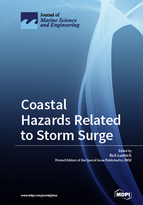Coastal Hazards Related to Storm Surge
A special issue of Journal of Marine Science and Engineering (ISSN 2077-1312).
Deadline for manuscript submissions: closed (1 April 2015) | Viewed by 121977
Special Issue Editor
Interests: modeling and observing coastal waters; storm surge modeling; coastal hazard prediction; event based flood forecasting
Special Issues, Collections and Topics in MDPI journals
Special Issue Information
Dear Colleagues,
Globally, the risk associated with living in the coastal zone is substantial and rising due to large and growing populations, commerce and infrastructure in coastal areas, relative sea level rise and the impacts of a warming climate on storm characteristics. The principal coastal hazards in much of the world are the storm surge, coastal flooding and surface waves caused by severe tropical or extra-tropical storms. As we seek to manage coastal risk and create more resilient coastal communities, it is essential that we continue to improve our understanding of, and skills in predicting these hazards and the hazard reducing effectiveness of mitigating measures ranging from man-made structures to nature-based features.
This Special Issue seeks to compile the current state of the art related to coastal hazards due to storm surge, flooding and surface waves. Contributions are encouraged in topics including:
- improved understanding of coastal hazards;
- improved physics for coastal hazard models;
- coupled hydrologic and coastal hazard models;
- surrogate modeling;
- improved solution algorithms for coastal hazard models, particularly for new generation computer architectures;
- statistical hazard prediction, particularly as influenced by relative sea level rise and climate change;
- deterministic and probabilistic, event-based forecasting;
- novel solutions for hazard reduction;
- design criteria for nature-based hazard reduction measures; and
- process-based and applied studies.
Prof. Rick Luettich
Guest Editor
Manuscript Submission Information
Manuscripts should be submitted online at www.mdpi.com by registering and logging in to this website. Once you are registered, click here to go to the submission form. Manuscripts can be submitted until the deadline. All submissions that pass pre-check are peer-reviewed. Accepted papers will be published continuously in the journal (as soon as accepted) and will be listed together on the special issue website. Research articles, review articles as well as short communications are invited. For planned papers, a title and short abstract (about 100 words) can be sent to the Editorial Office for announcement on this website.
Submitted manuscripts should not have been published previously, nor be under consideration for publication elsewhere (except conference proceedings papers). All manuscripts are thoroughly refereed through a single-blind peer-review process. A guide for authors and other relevant information for submission of manuscripts is available on the Instructions for Authors page. Journal of Marine Science and Engineering is an international peer-reviewed open access monthly journal published by MDPI.
Please visit the Instructions for Authors page before submitting a manuscript. The Article Processing Charge (APC) for publication in this open access journal is 2600 CHF (Swiss Francs). Submitted papers should be well formatted and use good English. Authors may use MDPI's English editing service prior to publication or during author revisions.
Keywords
- storm surge
- coastal flooding
- waves
- coastal hazards
- computer modeling
- coastal hazard reduction
- nature-based solutions
- storm surge barriers
- tropical cyclones
- hurricanes
- coastal storms
- sea level rise
- climate change






